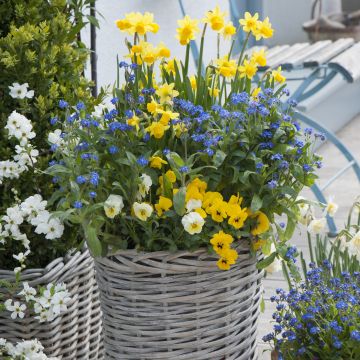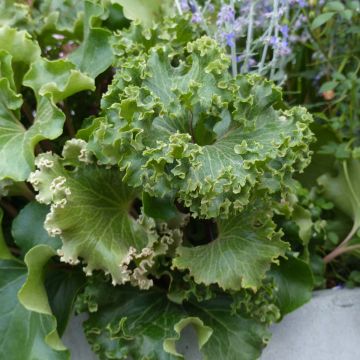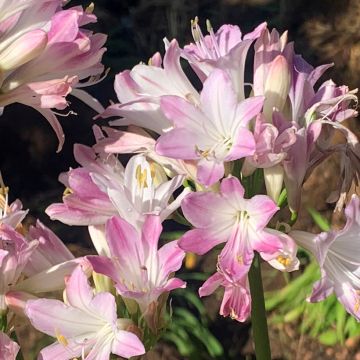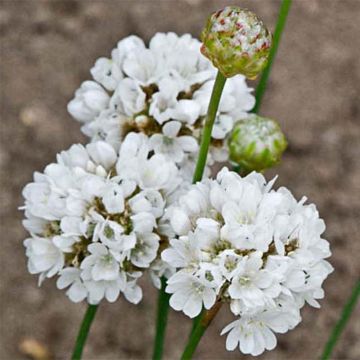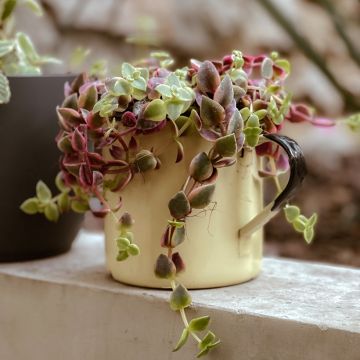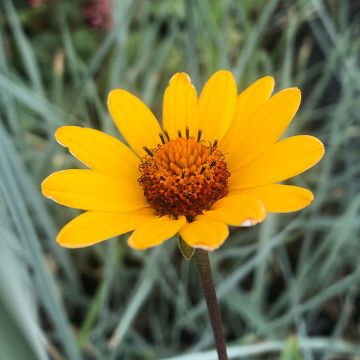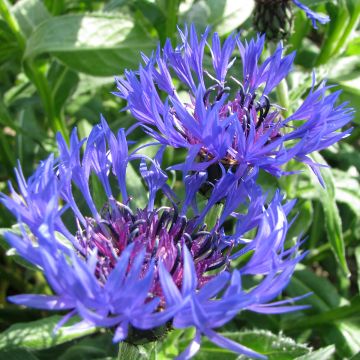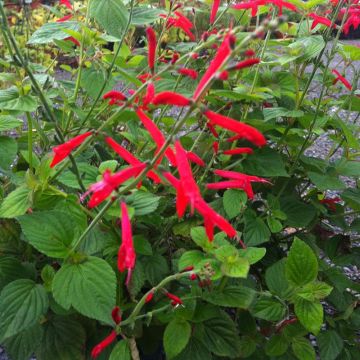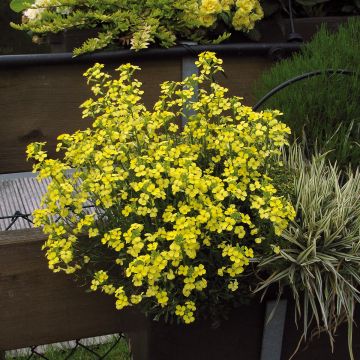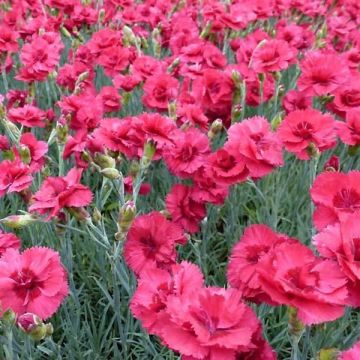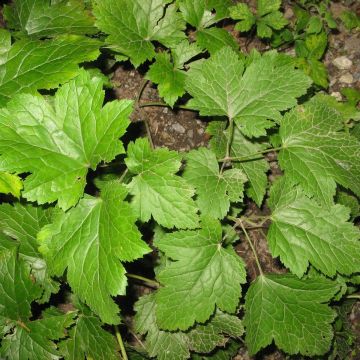Shipping country and language
Your country of residence may be:
Your country of residence is:
For a better user experience on our website, you can select:
Your shipping country:
Andorra
Austria
Belgium
Bulgaria
Canada
Chile
Croatia
Cyprus
Czechia
Denmark
Estonia
Finland
France
Germany
Greece
Hungary
Iceland
Ireland
Italy
Latvia
Lithuania
Luxembourg
Malta
Monaco
Netherlands
Poland
Portugal
Romania
Slovakia
Slovenia
Spain
Sweden
Switzerland
United Kingdom
We only deliver seed and bulb products to your country. If you add other products to your basket, they cannot be shipped.
Language:
French
German
Spanish
English
My Account
Hello
My wish lists
Plantfit
Log in / Register
Existing customer?
New customer?
Create an account to track your orders, access our customer service and, if you wish, make the most of our upcoming offers.
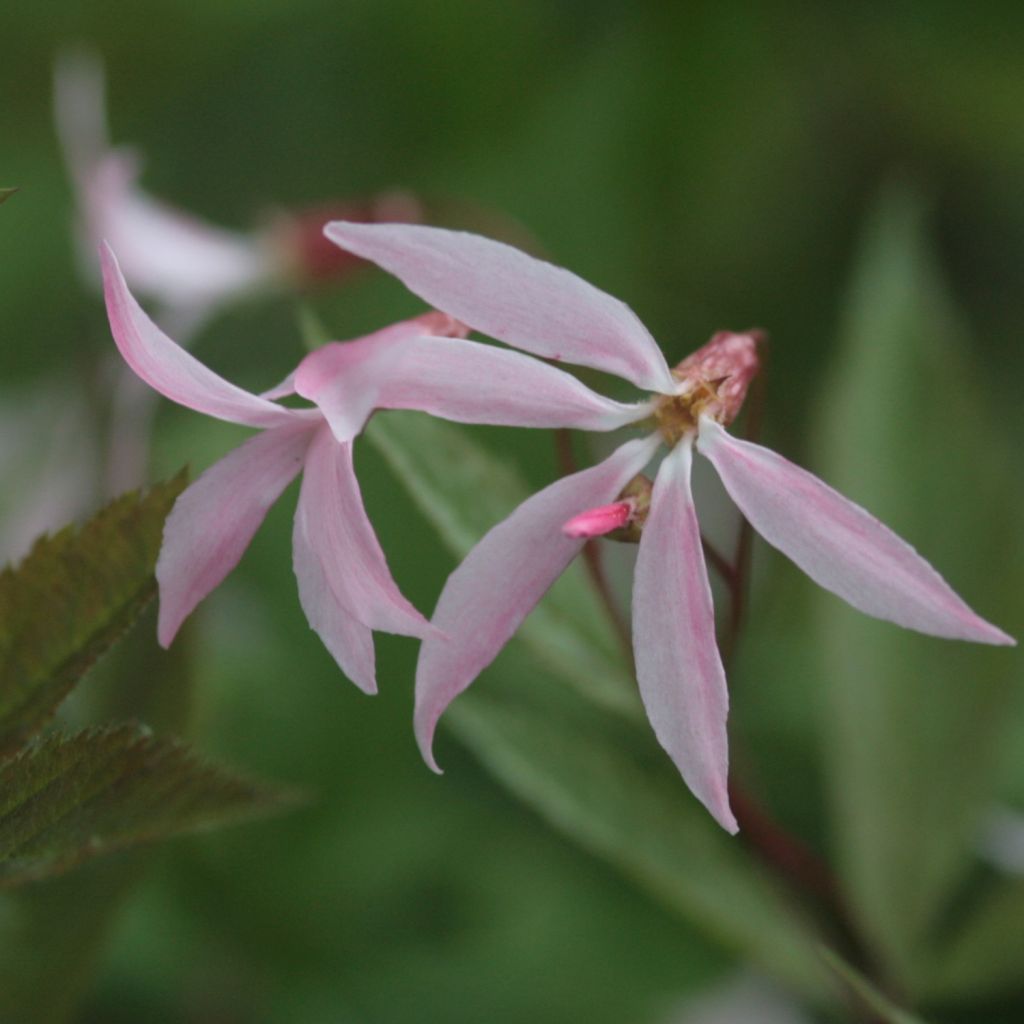

Gillenia trifoliata Pink Profusion - Gillenie à 3 feuilles rose pâle
Gillenia trifoliata Pink Profusion
Gillenia trifoliata Pink Profusion
Bowman's root, Indian physic, False ipecac, Indian hippo, Western dropwort
Order in the next for dispatch today!
Dispatch by letter from 3,90 €.
Delivery charge from 5,90 € Oversize package delivery charge from 6,90 €.
More information
This item is not available in your country.
Shipping country:
Andorra
Austria
Belgium
Bulgaria
Canada
Chile
Croatia
Cyprus
Czechia
Denmark
Estonia
Finland
France
Germany
Greece
Hungary
Iceland
Ireland
Italy
Latvia
Lithuania
Luxembourg
Malta
Monaco
Netherlands
Poland
Portugal
Romania
Slovakia
Slovenia
Spain
Sweden
Switzerland
United Kingdom
Schedule delivery date,
and select date in basket
This plant carries a 12 months recovery warranty
More information
We guarantee the quality of our plants for a full growing cycle, and will replace at our expense any plant that fails to recover under normal climatic and planting conditions.
From 5,90 € for pickup delivery and 6,90 € for home delivery
Express home delivery from 8,90 €.
Would this plant suit my garden?
Set up your Plantfit profile →
Description
Gillenia trifoliata 'Pink Profusion', sometimes called Three-leaf Gillenia, is a hardy, unique, and little-known perennial. However, it is a very ornamental and easy-to-grow plant that forms a beautiful flowering bush from early to late summer, generously adorned with airy panicles where a mist of pale-pink and red star-shaped flowers settle. Their calyx persists after flowering, punctuating the light foliage with carmine red. The foliage is tinged with bronze, turning rust-coloured in autumn. This plant prefers partial shade and moist, well-drained, humus-rich soils.
Gillenia trifoliata is a plant from the Rosaceae family, like the spireas to which it was once related. This rhizomatous perennial is now part of the Gillenia genus, which only has two species. It is native to North America, where it is found growing at high altitudes in the forests and rocky slopes of Canada and the eastern United States, from Arkansas to Tennessee. 'Pink Profusion' is a compact form of this species, with an upright and spreading habit. Slow to establish, it develops from a slow-growing stump. Its woody and slender stems, reddish-purple in colour, form a bush that is 60 to 80cm (24 to 32in) tall and 40 to 50cm (16 to 20in) wide. The flowering period extends from June to August-September, in the form of small star-shaped flowers measuring 3 to 4cm (1 to 2in) in diameter, clustered in panicles. The 7 petals that make up each flower are narrow, pale-pink washed with red, and supported by a reddish-purple calyx. The foliage consists of leaves with three more or less serrated leaflets, measuring 3 to 8cm (1 to 3in) long, deeply veined, with toothed margins. The foliage is dark green, tinged with bronze, and takes on a beautiful autumn colour before falling in winter.
Gillenia trifoliata 'Pink Profusion' is no more difficult to grow than weigelas or flowering currants, but far more graceful. It is simply less known, perhaps a little more temperamental despite its long flowering period and its willingness to grow in partial shade. It establishes itself slowly but surely on the edge of woodland, in a bed of flowering shrubs, or even in clear and cool woodland, away from the scorching sun. It can be paired with partial shade shrubs such as Mexican orange blossom, oakleaf hydrangea, Berberis 'Rosy Glow', and Cotoneaster lacteus, which will retain beautiful foliage in winter while gillenia rests. It creates a lovely scene alongside 'Brunette' bugbane and lungworts, rock meadowsweet, and Japanese painted fern, the rainbow fern.
Gillenia trifoliata Pink Profusion in pictures
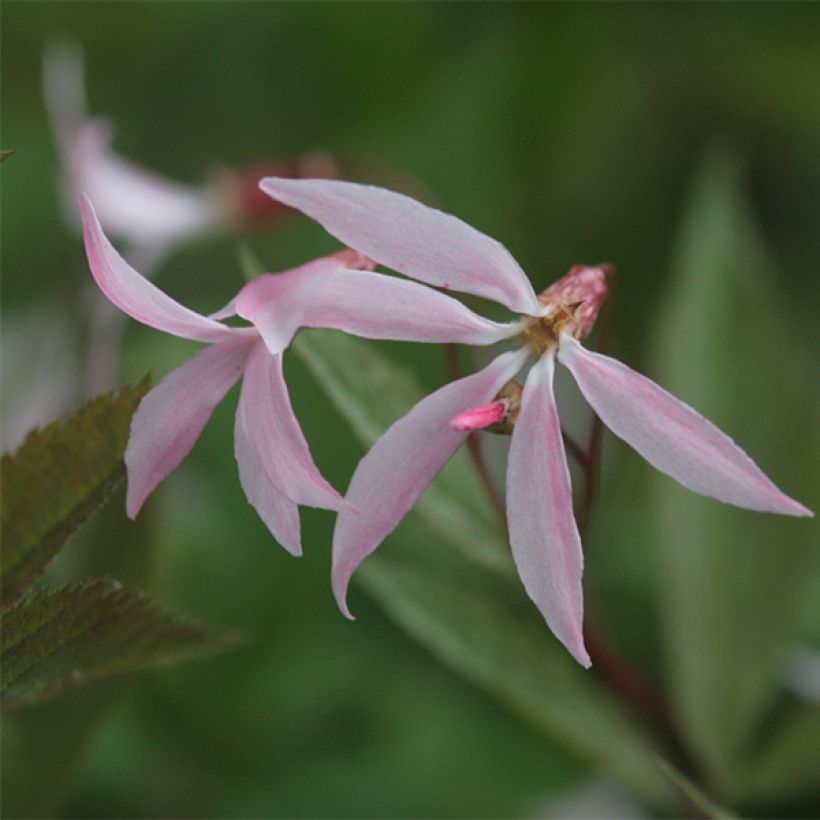

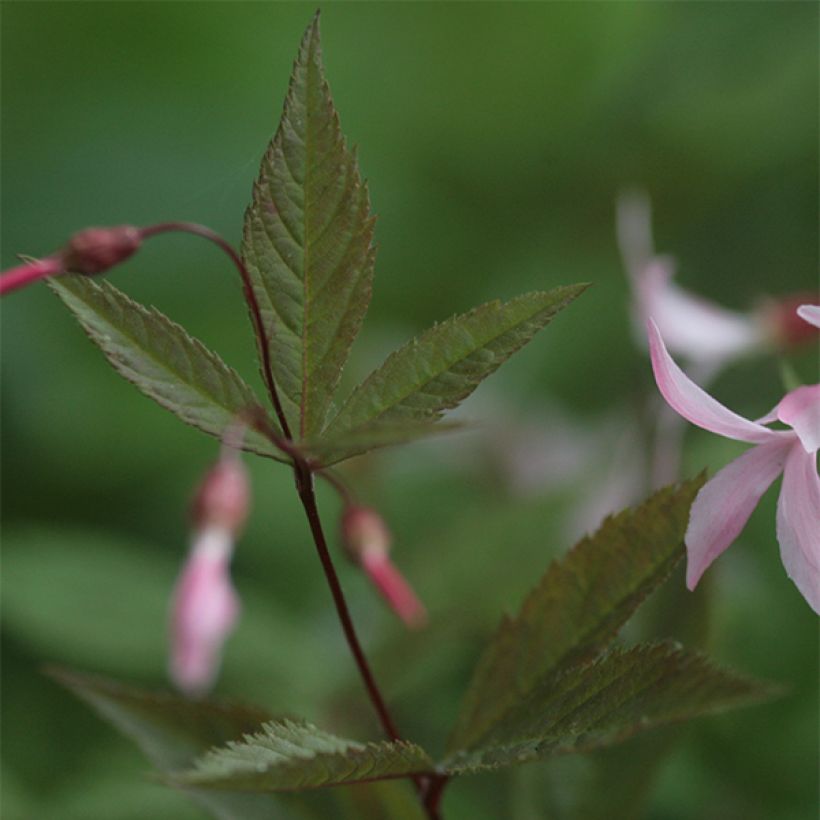

Flowering
Foliage
Plant habit
Botanical data
Gillenia
trifoliata
Pink Profusion
Rosaceae
Bowman's root, Indian physic, False ipecac, Indian hippo, Western dropwort
North America
Other Perennials A to Z
Planting and care
Plant the stump in non-calcareous soil, rich in humus, that is neither too dry nor too wet. It prefers a location with moderate sunlight and not too much shade.
Planting period
Intended location
Care
This item has not been reviewed yet - be the first to leave a review about it.
Summer flowering perennials
Haven't found what you were looking for?
Hardiness is the lowest winter temperature a plant can endure without suffering serious damage or even dying. However, hardiness is affected by location (a sheltered area, such as a patio), protection (winter cover) and soil type (hardiness is improved by well-drained soil).

Photo Sharing Terms & Conditions
In order to encourage gardeners to interact and share their experiences, Promesse de fleurs offers various media enabling content to be uploaded onto its Site - in particular via the ‘Photo sharing’ module.
The User agrees to refrain from:
- Posting any content that is illegal, prejudicial, insulting, racist, inciteful to hatred, revisionist, contrary to public decency, that infringes on privacy or on the privacy rights of third parties, in particular the publicity rights of persons and goods, intellectual property rights, or the right to privacy.
- Submitting content on behalf of a third party;
- Impersonate the identity of a third party and/or publish any personal information about a third party;
In general, the User undertakes to refrain from any unethical behaviour.
All Content (in particular text, comments, files, images, photos, videos, creative works, etc.), which may be subject to property or intellectual property rights, image or other private rights, shall remain the property of the User, subject to the limited rights granted by the terms of the licence granted by Promesse de fleurs as stated below. Users are at liberty to publish or not to publish such Content on the Site, notably via the ‘Photo Sharing’ facility, and accept that this Content shall be made public and freely accessible, notably on the Internet.
Users further acknowledge, undertake to have ,and guarantee that they hold all necessary rights and permissions to publish such material on the Site, in particular with regard to the legislation in force pertaining to any privacy, property, intellectual property, image, or contractual rights, or rights of any other nature. By publishing such Content on the Site, Users acknowledge accepting full liability as publishers of the Content within the meaning of the law, and grant Promesse de fleurs, free of charge, an inclusive, worldwide licence for the said Content for the entire duration of its publication, including all reproduction, representation, up/downloading, displaying, performing, transmission, and storage rights.
Users also grant permission for their name to be linked to the Content and accept that this link may not always be made available.
By engaging in posting material, Users consent to their Content becoming automatically accessible on the Internet, in particular on other sites and/or blogs and/or web pages of the Promesse de fleurs site, including in particular social pages and the Promesse de fleurs catalogue.
Users may secure the removal of entrusted content free of charge by issuing a simple request via our contact form.
The flowering period indicated on our website applies to countries and regions located in USDA zone 8 (France, the United Kingdom, Ireland, the Netherlands, etc.)
It will vary according to where you live:
- In zones 9 to 10 (Italy, Spain, Greece, etc.), flowering will occur about 2 to 4 weeks earlier.
- In zones 6 to 7 (Germany, Poland, Slovenia, and lower mountainous regions), flowering will be delayed by 2 to 3 weeks.
- In zone 5 (Central Europe, Scandinavia), blooming will be delayed by 3 to 5 weeks.
In temperate climates, pruning of spring-flowering shrubs (forsythia, spireas, etc.) should be done just after flowering.
Pruning of summer-flowering shrubs (Indian Lilac, Perovskia, etc.) can be done in winter or spring.
In cold regions as well as with frost-sensitive plants, avoid pruning too early when severe frosts may still occur.
The planting period indicated on our website applies to countries and regions located in USDA zone 8 (France, United Kingdom, Ireland, Netherlands).
It will vary according to where you live:
- In Mediterranean zones (Marseille, Madrid, Milan, etc.), autumn and winter are the best planting periods.
- In continental zones (Strasbourg, Munich, Vienna, etc.), delay planting by 2 to 3 weeks in spring and bring it forward by 2 to 4 weeks in autumn.
- In mountainous regions (the Alps, Pyrenees, Carpathians, etc.), it is best to plant in late spring (May-June) or late summer (August-September).
The harvesting period indicated on our website applies to countries and regions in USDA zone 8 (France, England, Ireland, the Netherlands).
In colder areas (Scandinavia, Poland, Austria...) fruit and vegetable harvests are likely to be delayed by 3-4 weeks.
In warmer areas (Italy, Spain, Greece, etc.), harvesting will probably take place earlier, depending on weather conditions.
The sowing periods indicated on our website apply to countries and regions within USDA Zone 8 (France, UK, Ireland, Netherlands).
In colder areas (Scandinavia, Poland, Austria...), delay any outdoor sowing by 3-4 weeks, or sow under glass.
In warmer climes (Italy, Spain, Greece, etc.), bring outdoor sowing forward by a few weeks.

